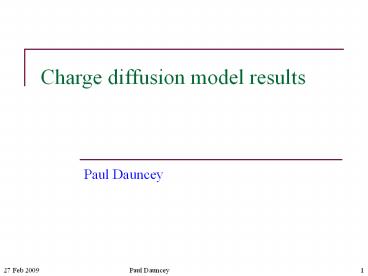Charge diffusion model results - PowerPoint PPT Presentation
Title:
Charge diffusion model results
Description:
These can be combined to give dr/d(kt) ... Exponential falloff through 5 5 pixel grid edges. Paul Dauncey. 3. Point geometry. 3. Paul Dauncey ... – PowerPoint PPT presentation
Number of Views:29
Avg rating:3.0/5.0
Title: Charge diffusion model results
1
Charge diffusion model results
- Paul Dauncey
2
Diffusion model (for details, see 29/2/08)
- Basic equations
- Charge conservation dr/dt ?.j 0 (so no
recombination) - Diffusive movement j -k?r where k is the
diffusion constant - These can be combined to give dr/d(kt) ?2r
- Time scaled by k, so no absolute timescale
- Work with 55 pixel grid and looks at charge in
central 33 pixels - 5050 points per pixel, each 11mm2 factor 2.5
finer than previous results - Divide epitaxial depth with same cell size
- 12 points, each 12mm/12 1mm ditto
- Use very simple numerics
- Three-point O(Dx2) approximation for ?2
- Forward (Newton) O(kDt) approximation for d/d(kt)
- Boundary conditions a bit tricky
- Perfect boundary at bottom of epitaxial layer
(z0) - Fraction of charge removed for some cells at top
of epitaxial layer (z12) - Exponential falloff through 55 pixel grid edges
3
Point geometry
- Giulios 21 points in triangle 9 pixels 189
values - 136 independent points after averaging
- Reflections/translations copy these to 900 points
- Most (but not edges/corners) duplicated 8 times
Paul Dauncey
3
4
GDS (Giulio) vs diffusion model
Diffusion
GDS
- Two parameters to tune using centre point 0
- Absorption of diodes use GDS perfect deep
p-well gives 44 - Absorption of n-well with deep p-well use full
GDS gives 31 - All other points then determined from diffusion
Paul Dauncey
4
5
Fractional charge spectra for models
Diffusion
GDS
- Fraction of charge seen in centre pixel for
uniform deposits over 33 pixel array - MIP-like spread in z direction
- Red shows distribution in centre pixel
- Corresponds to distribution of maximum signal if
reading all pixels - Suggestion of peak at charge fraction 0.3?
Paul Dauncey
5
6
Scale up from 5mm to 1mm steps
- 21 ? 351 points in triangle 9 pixels 3159
values - 136 ? 2916 independent points after averaging
- Copy these to 150150 22500 points
- Much larger fraction of points duplicated 8 times
Paul Dauncey
6
7
Fractional charge spectrum for 5mm steps
Paul Dauncey
7
8
Fractional charge spectrum for 1mm steps
- Peak at fraction of 0.32 of total charge approx
3 of hits - Results from wide flat region between pixels
Paul Dauncey
8
9
Depth dependence
MIP-like
10
Depth dependence
z 0.5mm
11
Depth dependence
z 1.5mm
12
Depth dependence
z 2.5mm
13
Depth dependence
z 3.5mm
14
Depth dependence
z 4.5mm
15
Depth dependence
z 5.5mm
16
Depth dependence
z 6.5mm
17
Depth dependence
z 7.5mm
18
Depth dependence
z 8.5mm
19
Depth dependence
z 9.5mm
20
Depth dependence
z10.5mm
21
Depth dependence
z11.5mm
22
Fractional spectrum 5mm with MIP-like z
Paul Dauncey
22
23
Fractional spectrum 1mm with MIP-like z
Paul Dauncey
23
24
Fractional spectrum 5mm with 55Fe-like z
- Still shows peak but details differ
- Need to do 351 points in xy 12 points in z
- Around 2 weeks saturated running
Paul Dauncey
24
25
Comparison with single diode
- Simple model 66mm2 diode in centre of 5050mm2
pixel - Most of the rest of the pixel is n-well with deep
p-well - Absorption parameters have same values
Paul Dauncey
25
26
Fractional spectrum 5mm for four diodes
Paul Dauncey
26
27
Fractional spectrum 5mm for single diode
- Average fraction seen in centre pixel half of
four diode average
Paul Dauncey
27
28
Conclusions
- The peak at 0.3 of the charge seems to be
reproducible - Details vary so exact position is not reliably
known - Shows up in both MIP-like and 55Fe-like deposits
- There is a significant dependence on the z depth
of the charge deposited - Charge from the bottom of the epitaxial layer is
not all lost by transverse diffusion to other
pixels - Implies a thicker epitaxial layer would increase
signal size - A single diode may give 0.5 of the signal of
four diodes - Very preliminary geometry parameters are not
fixed - Would need full GDS-based simulation to
cross-check a few points
18 Jan 2009
Paul Dauncey
28































